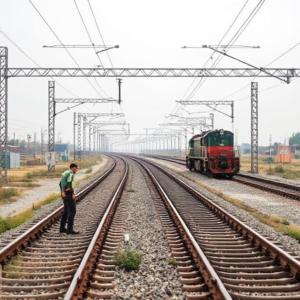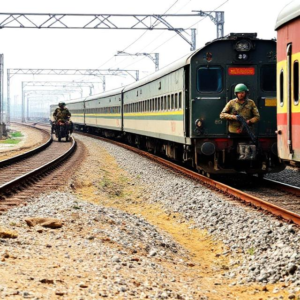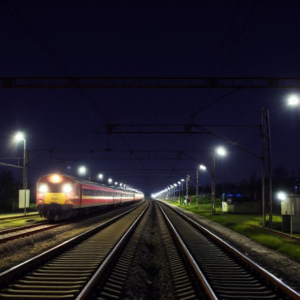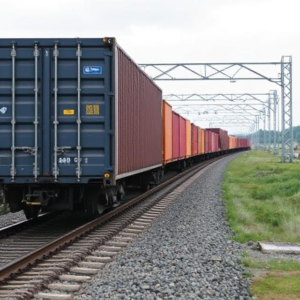Strengthening Railway Border Security Explained
Railway border security is about protecting the railway systems that run near or across the borders between different countries. These borders can be a point where illegal activities might happen, such as smuggling, human trafficking, or the movement of goods without proper checks. Strengthening security along these areas ensures that railways remain safe, secure, and free from crime or unauthorized activities.

Let’s break it down simply:
1. What is Railway Border Security?
Railway border security refers to the measures taken to protect railway networks that are close to international borders. This includes:
- Checking cargo or freight transported by trains.
- Monitoring passengers who travel across borders.
- Preventing illegal activities like smuggling, human trafficking, or terrorism.
- Ensuring that the train system is safe and secure for both passengers and goods.
2. Why is Railway Border Security Important?
Railways play a vital role in transporting people and goods across long distances, including between countries. Without strong security at railway borders, there can be risks like:
- Smuggling of goods (e.g., drugs, weapons, counterfeit products).
- Illegal immigration or trafficking of people.
- Terrorist activities that could harm passengers or damage infrastructure.
- Theft of valuable goods or materials during transit.
3. Key Challenges in Railway Border Security
Here are some challenges faced in maintaining strong railway border security:
- Vast border areas: Many railway borders cover long, remote areas that are difficult to monitor.
- Multiple entry points: Trains pass through various checkpoints, and some areas might have weak security or insufficient border control.
- Lack of technology: Not all railway systems have up-to-date security technology, making it harder to detect threats.
- Smuggling: Criminals often try to use trains to move goods across borders illegally, taking advantage of any weak security measures.
4. How Can Railway Border Security Be Strengthened?
There are several ways to improve security at railway borders to prevent illegal activities and ensure safe travel:
a. Improved Border Control and Inspection
- Customs and immigration checks at border stations help ensure that people and goods traveling across the border are properly inspected.
- Special customs officers may check documents, inspect cargo, and screen for illegal substances.
- Passenger checks ensure that no one is traveling without proper identification or documentation.
b. Advanced Security Technology
- Surveillance cameras and drones can be used to monitor the border areas 24/7.
- X-ray scanners and cargo screening machines help inspect goods quickly and efficiently for hidden threats.
- Biometric systems (like fingerprint scanners) help identify passengers and verify their identity.
c. Collaboration Between Countries
- Cross-border cooperation between neighboring countries is key. This means sharing information, resources, and coordinating efforts to protect the railway system.
- Joint patrols by border security forces from different countries can help cover larger areas.
- Countries can also share intelligence to track and prevent cross-border crimes or terrorism.
d. Railway Police and Security Personnel
- Trained railway police can patrol trains, stations, and border areas, looking for any suspicious activities.
- Security officers can be stationed at key points to ensure the safety of passengers and goods.
- K-9 units (dogs trained to detect drugs, explosives, or other illegal substances) are often used to enhance security.
e. Cargo Tracking and Monitoring
- Using GPS trackers or RFID tags on cargo helps monitor goods being transported across borders. This way, authorities can track the movement of goods and detect any irregularities.
- Automated systems can alert security personnel if any cargo goes off-course or if it enters a restricted area.
f. Public Awareness and Reporting
- Encouraging passengers and train staff to report suspicious activities can help prevent crimes or emergencies.
- Public campaigns can raise awareness about the importance of border security and encourage people to be vigilant.
5. Examples of Border Security Measures
Different countries use various techniques to strengthen their railway border security. Here are some examples:
- Smart Border Systems: Some countries have implemented smart border systems that use advanced facial recognition technology and biometric screening for passengers.
- Joint Border Patrols: Neighboring countries sometimes carry out joint patrols along the railway tracks near their borders to catch smugglers or illegal migrants.
- Automated Cargo Inspection: Modern railways use automated systems that inspect cargo in real time, reducing the need for manual checks and speeding up border crossings.
6. Benefits of Strengthening Railway Border Security
There are many advantages to strengthening railway border security:
- Prevents illegal activities like drug trafficking, smuggling, and human trafficking.
- Increases safety for passengers, ensuring that they travel in a secure environment.
- Improves efficiency by making it easier and quicker to inspect goods and passengers.
- Enhances international cooperation between countries to prevent cross-border crimes.
- Protects national interests by ensuring that no dangerous materials (like weapons or explosives) cross borders unchecked.
7. Challenges and Future Steps
While there are many solutions to improve railway border security, some challenges remain:
- Cost of implementation: Advanced technology and more security personnel can be expensive.
- Training: Border security personnel need ongoing training to keep up with new threats.
- Cross-border cooperation: Sometimes, political or logistical challenges can make cooperation difficult between countries.
In the future, security measures might become even more technologically advanced, with better use of artificial intelligence (AI) for monitoring, data analytics for identifying threats, and even more automated systems for scanning and tracking cargo.
8. Conclusion
Strengthening railway border security is essential to protect both passengers and goods. It helps prevent crime, smuggling, and terrorism that could affect the railway system and international relations. By using advanced technology, increasing international cooperation, and improving security personnel training, countries can ensure that their railway networks remain safe, secure, and efficient for everyone who relies on them.
Keywords: Railway Border, Railway











